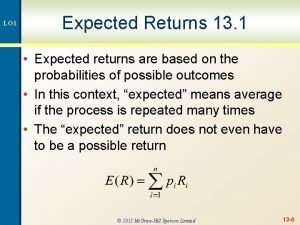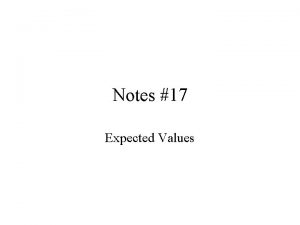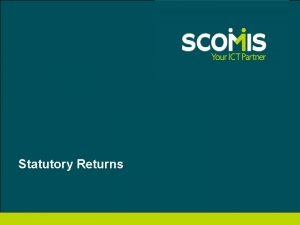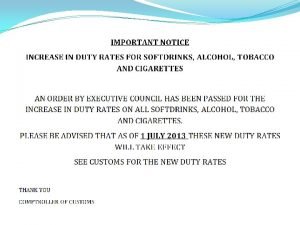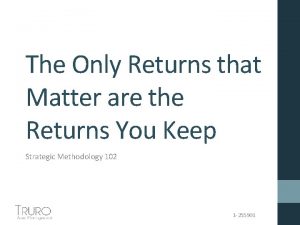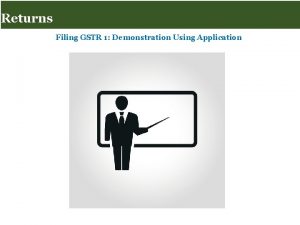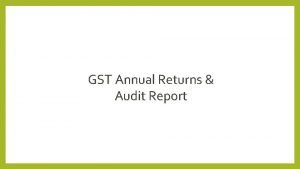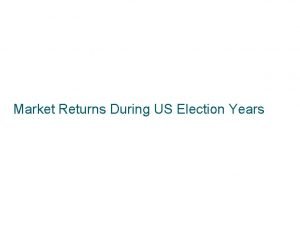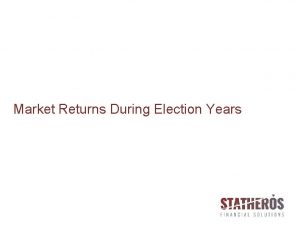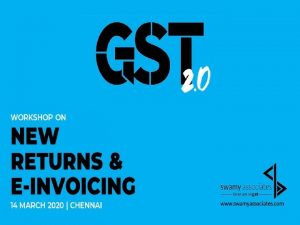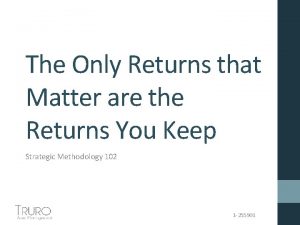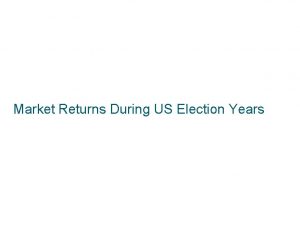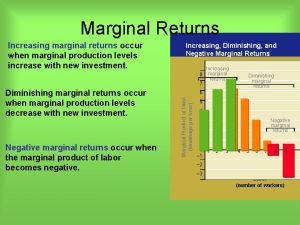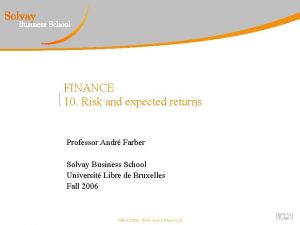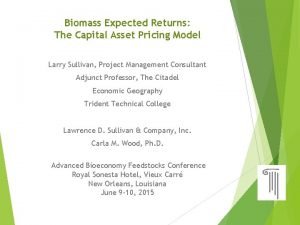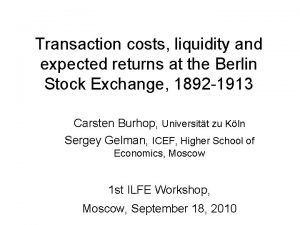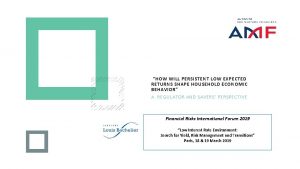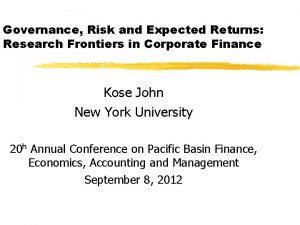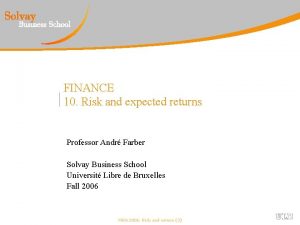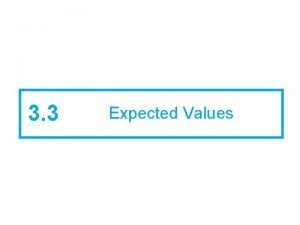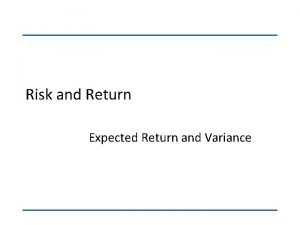Agenda for 29 July Chapter 13 Expected Returns
























- Slides: 24

Agenda for 29 July (Chapter 13) • Expected Returns, Variances, and Standard Deviations for individual securities • Expected Returns, Variances, and Standard Deviations for portfolios • Announcements, Surprises, and Expected Returns • Risk: Systematic and Unsystematic • Capital Asset Pricing Model 13 -1

Expected Returns • Expected returns are based on the probabilities of possible outcomes • In this context, “expected” means average if the process is repeated many times 13 -2

Variance and Standard Deviation • Variance and standard deviation measure the volatility of returns • Weighted average of squared deviations 13 -3

Example: Expected Returns • Suppose you have predicted the following returns for stocks C and T in three possible states of the economy. What are the expected returns? State Boom Normal Recession Probability 0. 3 0. 5 0. 2 C 0. 15 0. 10 0. 02 T___ 0. 25 0. 20 0. 01 • E(RC) =. 3(15) +. 5(10) +. 2(2) = 9. 9% • E(RT) =. 3(25) +. 5(20) +. 2(1) = 17. 7% 13 -4

Example: Variance & Standard Deviation • What are the variance and standard deviation for each stock? • Stock C § 2 =. 3(0. 15 -0. 099)2 +. 5(0. 10 -0. 099)2 +. 2(0. 02 -0. 099)2 = 0. 002029 § = 4. 50% • Stock T § 2 =. 3(0. 25 -0. 177)2 +. 5(0. 20 -0. 177)2 +. 2(0. 01 -0. 177)2 = 0. 007441 § = 8. 63% 13 -5

Portfolios • A portfolio is a collection of assets • An asset’s risk and return are important in how they affect the risk and return of the portfolio • The risk-return trade-off for a portfolio is measured by the portfolio expected return and standard deviation, just as with individual assets 13 -6

Portfolio Expected Return • The expected return of a portfolio is the weighted average of the expected returns of the respective assets in the portfolio • You can also find the expected return by finding the portfolio return in each possible state and computing the expected value as we did with individual securities 13 -7

Portfolio Variance • Compute the portfolio return for each state: RP = w 1 R 1 + w 2 R 2 + … + wm. Rm • Compute the expected portfolio return using the same formula as for an individual asset • Compute the portfolio variance and standard deviation using the same formulas as for an individual asset 13 -8

Example: Portfolio Expected Return and Standard Deviation • Consider the following information on returns and probabilities: §Invest 50% of your money in Asset A and 50% in B State Boom Bust Probability A B Portfolio. 5 30% -5% 12. 5%. 5 -10% 25% 7. 5% • What are the expected return and standard deviation for each asset? • What are the expected return and standard deviation for the portfolio? • Download the portfolio problem spreadsheet. 13 -9

Expected vs. Unexpected Returns • Realized returns are generally not equal to expected returns • There is the expected component and the unexpected component §At any point in time, the unexpected return can be either positive or negative §Over time, the average of the unexpected component is zero; by definition, something that is unexpected is purely random! 13 -10

Announcements and News • Announcements and news contain both an expected component and a surprise component • It is the surprise component that affects a stock’s price and therefore its return (positively or negatively) • This is apparent when we watch how stock prices move in response to news about the firm that is not anticipated; e. g. , a better or worse than expected earnings announcement 13 -11

Systematic Risk • Also known as non-diversifiable risk or market risk • Includes risk factors that affect firms generally; e. g. , macroeconomic factors such as GDP, inflation, interest rates, demographic change, changes in consumer preferences, and so forth. 13 -12

Unsystematic Risk • Also known as diversifiable or unique risk • Includes risk factors that are firm-specific; e. g. , property damage, lawsuits, product recalls, labor strikes, theft of intellectual property by hackers, and so forth. 13 -13

Returns • Total Return = expected return + unexpected return • Unexpected return = systematic portion + unsystematic portion • Therefore, total return can be expressed as follows: Total Return = expected return + systematic portion + unsystematic portion 13 -14

Systematic and Unsystematic Risk 15

Systematic and Unsystematic Risk 16

Systematic Risk Principle • There is a reward for bearing risk • There is not a reward for bearing risk unnecessarily • The expected return on a risky asset depends only on that asset’s systematic risk since unsystematic risk can be diversified away 13 -17

Measuring Systematic Risk • How do we measure systematic risk? §We use the beta coefficient • What does beta tell us? §A beta of 1 implies the asset has the same systematic risk as the overall market §A beta < 1 implies the asset has less systematic risk than the overall market §A beta > 1 implies the asset has more systematic risk than the overall market 13 -18

Total vs. Systematic Risk • Consider the following information: Standard Deviation Security C Security K 20% 30% Beta 1. 25 0. 95 • Which security has more total risk? • Which security has more systematic risk? • Which security should have the higher expected return? 13 -19

The Risk Reward Ratio for the Overall Market A Graphical Illustration Lecture 13: Capital Market Theory 20

The Capital Asset Pricing Model (CAPM) • In equilibrium, all assets and portfolios must have the same reward-to-risk ratio, and they all must equal the reward-to-risk ratio for the market; i. e. , • Since the beta of the market is (by definition) equal to 1, this implies that 13 -21

Factors Affecting Expected Return • Pure time value of money: measured by the risk-free rate • Reward for bearing systematic risk: measured by the market risk premium • Amount of systematic risk: measured by beta 13 -22

The Capital Asset Pricing Model (CAPM) • The capital asset pricing model defines the relationship between risk and return • If we know an asset’s systematic risk, we can use the CAPM to determine its expected return • This is true whether we are talking about financial assets or physical assets 13 -23

Field Research – look up betas for publicly traded companies • Apple • Google • JP Morgan Chase • Ford • Walmart • Amazon • Facebook 13 -24
 Agenda sistemica y agenda institucional
Agenda sistemica y agenda institucional Chapter 19 section 3 japan returns to isolation answer key
Chapter 19 section 3 japan returns to isolation answer key Section 3 japan
Section 3 japan A strange day in july picture
A strange day in july picture Harris burdick pictures missing in venice
Harris burdick pictures missing in venice July 1-4 1863
July 1-4 1863 Tender mean
Tender mean Criciúma ec
Criciúma ec 2001 july 15
2001 july 15 2003 july 17
2003 july 17 July 30 2009 nasa
July 30 2009 nasa Sources nso frenchhowell neill mit technology...
Sources nso frenchhowell neill mit technology... What is the significance of july 4 1776 brainpop
What is the significance of july 4 1776 brainpop Poppies in july aoifes notes
Poppies in july aoifes notes Hurrah for the fourth of july cartoon
Hurrah for the fourth of july cartoon Poppies in july poem
Poppies in july poem Gdje se rodio nikola tesla
Gdje se rodio nikola tesla Ctdssmap payment schedule july 2021
Ctdssmap payment schedule july 2021 July 1969
July 1969 Slidetodoc.com
Slidetodoc.com Monday 13th july
Monday 13th july On july 18 2001 a train carrying hazardous chemicals
On july 18 2001 a train carrying hazardous chemicals July 4 sermon
July 4 sermon June too soon july stand by
June too soon july stand by July 2 1937 amelia earhart
July 2 1937 amelia earhart

























